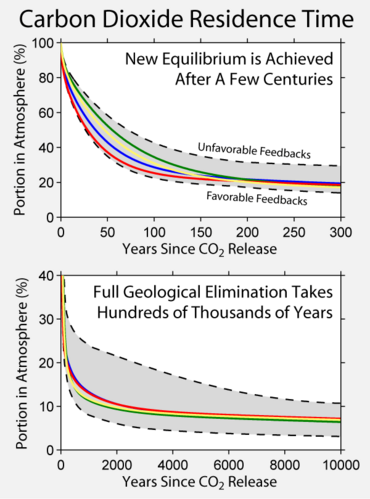
Long-Term Legacy of Fossil Fuels
It is commonly assumed that the ‘CO2 problem’ will only persist for a few centuries, and will rapidly dissipate once we stop emitting CO2. This perception is probably false. Model runs with simple box models such as this one suggest otherwise.
There are valid scientific reasons for suspecting that a fraction of CO2 emissions will remain in the atmosphere for many millennia after emissions cease, possibly even for hundreds of thousands of years. CO2 emissions may leave a legacy that will still be around long after nuclear waste is no longer radioactive. This has implications for issues such as ice-sheet melting, long-term sea-level rise and even for the likelihood of future ice ages.
JModels
Try applying 4000 Gt C of fossil fuel CO2 near the beginning of the model run (see above for how to do this) and then set the run duration to a longer interval, for instance 3000 years. If you have time, you could try 30,000 years or even longer. At the end of the run click ‘Show Final State’ and look at the atmospheric CO2 level at the end of the run. Has it returned to its pre-industrial value of 280 ppmv? You can also examine the trajectory of atmospheric CO2 through the model run on the middle-right panel of the first page of the graphs. You should see that the amount of CO2 in the atmosphere has declined following the end of emissions, but that it never goes all the way back down to the starting value.
Further Reading:
D. Archer and A. Ganopolski (2005).A movable trigger: Fossil fuel CO2 and the onset of the next glaciation. Geochemistry, Geophysics, Geosystems 6, Art. no. Q05003.
D. Archer (2005). Fate of fossil fuel CO2 in geologic time. Journal of Geophysical Research-Oceans 110, Art. no. C09S05.